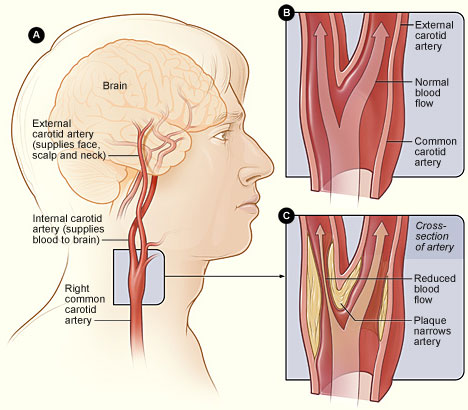What Is Carotid Ultrasound?
Carotid (ka-ROT-id) ultrasound is a painless and harmless test that uses high-frequency sound waves to create pictures of the insides of your carotid arteries.
You have two common carotid arteries, one on each side of your neck. They each divide into internal and external carotid arteries.
The internal carotid arteries supply oxygen-rich blood to your brain. The external carotid arteries supply oxygen-rich blood to your face, scalp, and neck.
Overview
Carotid ultrasound shows whether a waxy substance called plaque (plak) has built up in your carotid arteries. The buildup of plaque in the carotid arteries is called carotid artery disease.
Carotid Arteries

Figure A shows the location of the right carotid artery in the head and neck. Figure B is a cross-section of a normal carotid artery that has normal blood flow. Figure C shows a carotid artery that has plaque buildup and reduced blood flow.
Over time, plaque can harden or rupture (break open). Hardened plaque narrows the carotid arteries and reduces the flow of oxygen-rich blood to the brain.
If the plaque ruptures, a blood clot can form on its surface. A clot can mostly or completely block blood flow through a carotid artery, which can cause a stroke.
A piece of plaque or a blood clot also can break away from the wall of the carotid artery. The plaque or clot can travel through the bloodstream and get stuck in one of the brain's smaller arteries. This can block blood flow in the artery and cause a stroke.
A standard carotid ultrasound shows the structure of your carotid arteries. Your carotid ultrasound test might include a Doppler ultrasound. Doppler ultrasound is a special test that shows the movement of blood through your blood vessels.
Your doctor might need results from both types of ultrasound to fully assess whether you have a blood flow problem in your carotid arteries.
Clinical trials are research studies that explore whether a medical strategy, treatment, or device is safe and effective for humans. To find clinical trials that are currently underway for Carotid Ultrasound, visit www.clinicaltrials.gov.
The NHLBI updates Health Topics articles on a biennial cycle based on a thorough review of research findings and new literature. The articles also are updated as needed if important new research is published. The date on each Health Topics article reflects when the content was originally posted or last revised.















